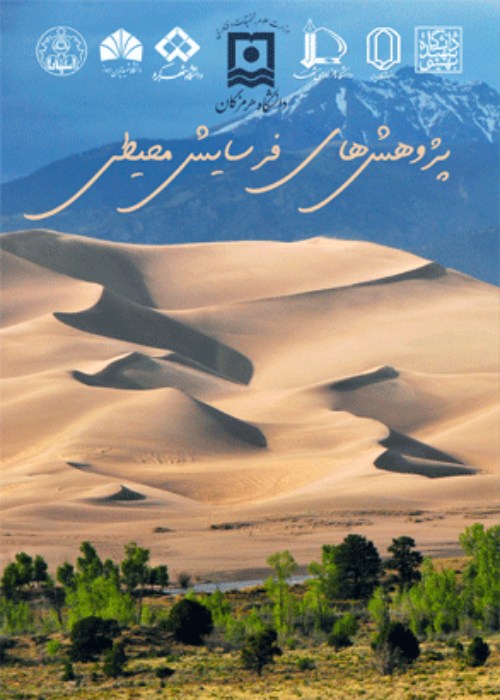Assessing the Accuracy of Supervised Classification Algorithms for Land ulUse Map Extraction (Study Area: Taham Watershed)
Remote sensing and Geographic information system have the capability of detecting and/or monitoring the features of the earth’s surface using satellite images and have different radiometric, spectral, spatial, and temporal resolutions. These technologies resolutions have several advantages in order to minimize the time and cost of extracting Land cover and Land use (LULC). In addition, the remote sensing provides important and different kinds of remote data sources to extract LULC information. Remote sensing data are widely used and applied to perform classification of LULC in the world. Remote sensing data has the ability of updating information about all of the features located on the earth’s surface. The classification of remote sensing imagery is an important method in order to determine the LULC information. Classification approaches are divided into two categories: pixel base and objected oriented base classifiers. The present study's aims are conducting land use classification by making a comparison between different algorithms in Taham watershed in Zanjan province.
In this research, Landsat8 satellite images (25 July) were used to perform preprocessing and processing steps. Geometric, radiometric and atmospheric corrections were used to eliminate the image noise. In the next step, for the existing uses in the region, first, field samples (160 educational points) were collected separately for each use in the region by using field visits and the Global Positioning System (GPS). Educational samples were divided into two categories, 70% of them were used for classification and 30% were used to accuracy of classification methods. After applying the image corrections according to the studied algorithms for each algorithm using EVVI 5.3 software and educational samples, the land use role for the study area was prepared. According to the sampling, five classes in the study area include agricultural land, rangeland, barren land, residential areas and waterbody areas. To evaluate the accuracy of the classified maps, the error matrix was calculated by using ENVI software. For this purpose, in the present study, the coefficients of Overall Accuracy, Kappa Coefficient, Producer Accuracy, User Accuracy, Commission and Omission had been used.
The aim of this research was to classify and map land-use/land-cover of the study area using remote sensing and Geospatial Information System (GIS) techniques and includes two sections, namely Land use/Landover (LULC) classification and accuracy assessment. In this study, the supervised classification and four algorithms (including SVM, MLC, MDC and MC) were used and then five classes for the study area including agricultural land (3.26), rangeland land (89.85), residential land (0.15), waterbody (1.19) and barren lands (5.55) were extracted. Also, the results showed the SVM algorithm with overall accuracy (98.24), kappa coefficient (0.969) as the most accurate, MDC algorithm with overall accuracy (94.36) and kappa coefficient (0.9) as the last priority in this study. According to the results of Tables 2 and 3, it can be seen that the percentages related to the five land use classes (residential areas, irrigated areas, agricultural lands, rangelands and baire lands) are mostly above 90%. This indicates that a high percentage of the pixels associated with these uses are properly classified. This study also presents essential source of information whereby planners and decision makers can use to plan sustainably measures for the environment.
Today, the use of LULC mapping is a vital issue for collecting data in urban planning, comprehensive watershed management, identification of effective factors, and environmental monitoring. The use of remote sensing technology with different satellite images is recommended as the best strategy for preparing LULC maps. By using different systems the limitations and capabilities of these images can be identified. The purpose of this study was to generate LULC thematic maps by comparing different algorithms, using maximum likelihood, minimum distance from mean, Mahalanobis and Support vector machine in Tham watershed in Zanjan province by applying Landsat 8 images. After performing all of the necessary corrections with the steps of preprocessing, processing and analysis of satellite images, four different algorithms were used to classify the satellite images. Support vector machine algorithm with an accuracy equal to 98.24% and kappa coefficient with an accuracy equal to 0.969 has the highes accuracy among other algorithms. Of course, the maximum likelihood algorithm with 97.45% overall accuracy and kappa coefficient equal to 0.961 have the highest accuracy in extracting land use maps and the slightest difference with the support vector machine algorithm, respectively. In other words, it can be said that the two support vector machine algorithms and the maximum likelihood have a high level of accuracy in extracting the land user maps. The two algorithms of Mahalanobis distance and minimum distance from the mean were ranked next.
- حق عضویت دریافتی صرف حمایت از نشریات عضو و نگهداری، تکمیل و توسعه مگیران میشود.
- پرداخت حق اشتراک و دانلود مقالات اجازه بازنشر آن در سایر رسانههای چاپی و دیجیتال را به کاربر نمیدهد.



